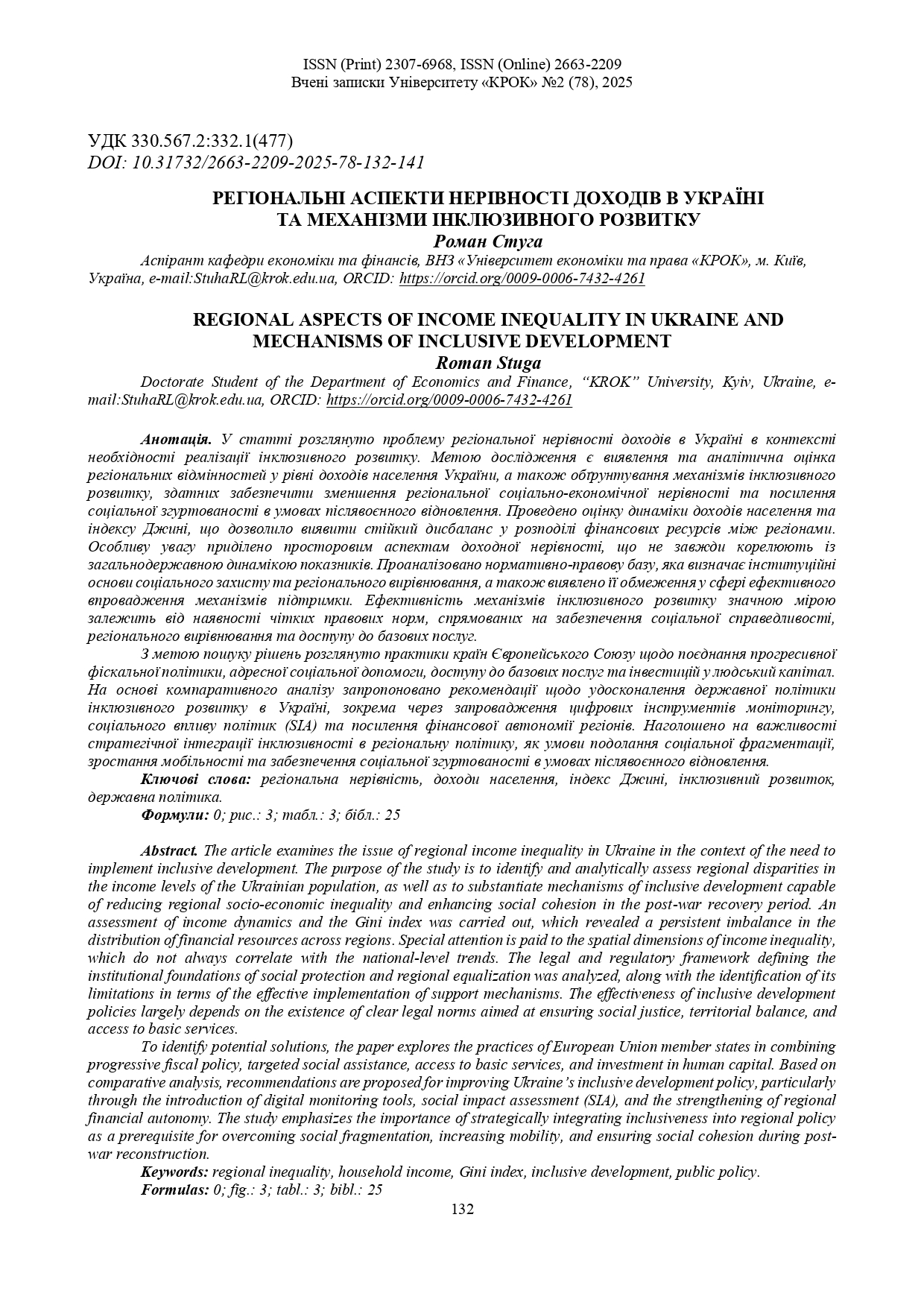REGIONAL ASPECTS OF INCOME INEQUALITY IN UKRAINE AND MECHANISMS OF INCLUSIVE DEVELOPMENT
DOI:
https://doi.org/10.31732/2663-2209-2025-78-132-141Keywords:
regional inequality, household income, Gini index, inclusive development, public policyAbstract
The article examines the issue of regional income inequality in Ukraine in the context of the need to implement inclusive development. The purpose of the study is to identify and analytically assess regional disparities in the income levels of the Ukrainian population, as well as to substantiate mechanisms of inclusive development capable of reducing regional socio-economic inequality and enhancing social cohesion in the post-war recovery period. An assessment of income dynamics and the Gini index was carried out, which revealed a persistent imbalance in the distribution of financial resources across regions. Special attention is paid to the spatial dimensions of income inequality, which do not always correlate with the national-level trends. The legal and regulatory framework defining the institutional foundations of social protection and regional equalization was analyzed, along with the identification of its limitations in terms of the effective implementation of support mechanisms. The effectiveness of inclusive development policies largely depends on the existence of clear legal norms aimed at ensuring social justice, territorial balance, and access to basic services.
To identify potential solutions, the paper explores the practices of European Union member states in combining progressive fiscal policy, targeted social assistance, access to basic services, and investment in human capital. Based on comparative analysis, recommendations are proposed for improving Ukraine’s inclusive development policy, particularly through the introduction of digital monitoring tools, social impact assessment (SIA), and the strengthening of regional financial autonomy. The study emphasizes the importance of strategically integrating inclusiveness into regional policy as a prerequisite for overcoming social fragmentation, increasing mobility, and ensuring social cohesion during post-war reconstruction.
Downloads
References
Верховна Рада України. (1997). Закон України «Про місцеве самоврядування в Україні» № 280/97-ВР від 21.05.1997. https://zakon.rada.gov.ua/laws/show/280/97-%D0%B2%D1%80
Верховна Рада України. (1999a). Закон України «Про загальнообов’язкове державне соціальне страхування» № 1105-XIV від 23.09.1999. https://zakon.rada.gov.ua/laws/show/1105-14
Верховна Рада України. (1999b). Закон України «Про прожитковий мінімум» № 966-XIV від 15.07.1999. https://zakon.rada.gov.ua/laws/show/966-14
Верховна Рада України. (2000). Закон України «Про державні соціальні стандарти та державні соціальні гарантії» № 2017-III від 05.10.2000. https://zakon.rada.gov.ua/laws/show/2017-14
Верховна Рада України. (2010). Бюджетний кодекс України № 2456-VI від 08.07.2010 (у редакції зі змінами). https://zakon.rada.gov.ua/laws/show/2456-17
Верховна Рада України. (2019). Закон України «Про соціальні послуги» № 2671-VIII від 17.01.2019. https://zakon.rada.gov.ua/laws/show/2671-19
Державна служба статистики України. (2022). Доходи населення по регіонах. https://data.gov.ua/dataset/8ff2fef2-e63f-468d-8ac1-2cd806be5cb8/resource/b204260c-3a52-4b44-856e-f41cc99e29bc
Кабінет Міністрів України. (2020). Постанова № 695 «Про затвердження Державної стратегії регіонального розвитку на період до 2027 року» від 05.08.2020. https://zakon.rada.gov.ua/laws/show/695-2020-%D0%BF
Корецький, В. І. (2020). Регіональний розвиток в умовах децентралізації: оцінка ефективності механізмів вирівнювання. Регіональна економіка, (1), 72–81. https://doi.org/10.32782/2413-9971/2020-1-8
Кравченко, С. І., Колот, В. М., & Бандурка, О. М. (2019). Проблеми соціальної нерівності та фіскальні інструменти її згладжування в Україні. Фінанси України, (6), 33–45.
Куліш, А. М., & Гой, А. П. (2021). Соціальні трансферти та їх вплив на доходну нерівність в Україні. Економіка і держава, (7), 78–82.
Міністерство соціальної політики України. (2020). Проєкт Національної стратегії подолання бідності до 2030 року (наказ № 847). https://www.msp.gov.ua/news/19786.html
Aiginger, K., & Rodrik, D. (2020). Rebirth of industrial policy and an agenda for the twenty-first century. Journal of Industry, Competition and Trade, 20, 189–207. https://doi.org/10.1007/s10842-019-00322-3
Eurofound. (2023). Income inequalities and inclusive growth in the EU. https://www.eurofound.europa.eu
European Commission. (2022). Country report Poland 2022. https://commission.europa.eu
Eurostat. (2023). Living conditions in Europe. https://ec.europa.eu/eurostat/statistics-explained
IMF. (2023). Spain: Selected issues. International Monetary Fund. https://www.imf.org
Krasota O., Melnyk T. Social Inclusion as an Instrument for Reducing Socio-Economic Inequality. Scientific Papers of the University of Pardubice. Series D. 2020. 28(3). 1192. DOI: https://doi.org/10.46585/sp28031192
Milanović, B. (2016). Global inequality: A new approach for the age of globalization. Harvard University Press.
OECD. (2020). A framework for inclusive growth. OECD Publishing. https://www.oecd.org/inclusive-growth/
OECD. (2022). Income inequality and poverty by country. Organisation for Economic Co-operation and Development. https://data.oecd.org/inequality/income-inequality.htm
Rodríguez-Pose, A. (2018). The revenge of the places that don’t matter (and what to do about it). Cambridge Journal of Regions, Economy and Society, 11(1), 189–209. https://doi.org/10.1093/cjres/rsx024
Shevchuk, A. V. (2022). Social resilience and inclusive regional development under wartime conditions. Ukrainian Journal of Public Policy, 9(3), 51–64.
Stiglitz, J. E. (2012). The price of inequality: How today’s divided society endangers our future. W.W. Norton & Company.
World Bank. (2023). Europe and Central Asia economic update: Inclusive growth. https://www.worldbank.org/en/region/eca
World Bank. (2024). Gini index (World Bank estimate) – Ukraine. FRED, Federal Reserve Bank of St. Louis. https://fred.stlouisfed.org/series/SIPOVGINIUKR

Downloads
Published
How to Cite
Issue
Section
License

This work is licensed under a Creative Commons Attribution-NonCommercial 4.0 International License.

